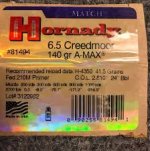Good info. My preference is Anneal & FL Bushing with shoulder bump each time. Personally, I haven’t tried a jam, light jam, or slightly off the lands approach yet. I’ve measured my jam with the Hornady modified case a few times, & I did contemplate giving it a try, but didn’t feel comfortable with it given my skill set. I’ve only been reloading for a year or two, so in that time, I’ve focused more on refining & improving my brass prep process, my tools, my powder measuring accuracy potential, and my load development practices instead. I was afraid I might get into trouble with pressure spikes if I got too far into the lands, & decided to play it safe due to my experience level, & restricted myself to magazine length and slightly shorter seating depths. Mag length & under may not provide me with the best accuracy potential for my rifle, but it’s served me pretty well so far, & feel like it’s kept me out of trouble being relatively new at this hobby.
I do a good bit of reading, & I was intrigued by something Eric Cortana proposed about seating depth in relation to bullet release & barrel harmonics. My interpretation was that he liked to think of it as a Sine Wave. So, in my mind, if a Sine Wave runs the same amplitude of peaks & valleys throughout the practical range of possible seating depths, in theory, one should be able to find a seating depth that will fall into the sweet spot of that Sine Wave, even at mag length or shorter, which is comparable to that which could be attained from a jam, slight jam, or slightly off. Makes sense, but I also think a jam, slight jam, or slightly off may possibly add a new dynamic where magic happens by effecting the initial pressure curve, which could either add magic to your performance or headache. My thoughts were for me, the juice just wouldn’t be worth the squeeze bc to maintain the performance characteristic a jam, slight jam, or just off seating depth offers, one would have to continually monitor and maintain that tight distance which is married to that specific seating depth in relation to the amount of throat erosion encountered by the barrel over time. I suppose a good seating depth at mag length or shorter would have to account for that erosion as well, but maybe it isn’t as critical? Who knows?
Geez... my head hurts just trying to to put all those thoughts into words

. Can it be done to great effect? Yes, & many ppl do, but for me, I don’t know that my skill level is quite up to it just yet. My biggest improvements so far in performance have come from using quality brass (I love Lapua in my .223, but couldn’t find any for my 6.5cm), annealing to relieve work hardness & reduce spring back, as consistent shoulder bump & neck tension as I can get out of my Type S Bushing Die (targeting .002 on each), and an accurate scale. Those improvements made my results look like I’ve been reloading longer than I have, lol. Still much to learn tho.



